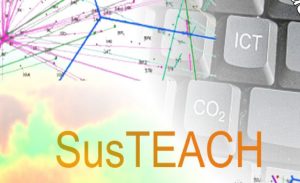The Open University takes sustainability seriously! In addition to establishing carbon reduction measures to meet Government targets, the OU is interested in how the design of different higher education (HE) systems impacts on the environment. How do the distance education systems used by the OU, as a leading provider of creative open learning, compare with conventional campus-based HE systems in the UK?
The first major quantitative study to assess the energy consumption and carbon impacts of campus-based and distance HE systems was the 2003-05 Factor 10 Visions study ‘Towards Sustainable HE’ led by Professors Robin Roy and Stephen Potter. The study found that on average the production and delivery of distance teaching consumed nearly 90% less energy and produced 85% fewer CO2 emissions than campus-based HE courses and modules. The much lower impacts of distance learning was found to be mainly due to a major reduction in the amount of student travel, economies of scale in utilization of the campus site, and the elimination of much of the energy consumption associated with students’ housing.
 In recent years, the use of Information and Communication Technologies (ICTs) has become increasingly pervasive in HE leading to innovative, online models of teaching and learning. This raises the question – does the increased use of ICTs in HE teaching have better or worse environmental impacts than traditional face-to-face and distance teaching models?
In recent years, the use of Information and Communication Technologies (ICTs) has become increasingly pervasive in HE leading to innovative, online models of teaching and learning. This raises the question – does the increased use of ICTs in HE teaching have better or worse environmental impacts than traditional face-to-face and distance teaching models?
This led to the 2011-12 JISC-funded SusTEACH project led by Professor Andy Lane and Dr Sally Caird, which examined the role of ICTs in HE Teaching Models and their effect on carbon reduction. We conducted a carbon-based environmental assessment and data analysis of 30 HE courses and modules, across UK institutions that used a range of teaching models. We assessed the key sources of carbon impacts associated with HE teaching, including staff and student travel, the purchase and use of educational materials and ICT devices, residential energy consumption, and campus site operations. As with Factor 10, SusTEACH found that the main sources of carbon impacts in HE Teaching Models were associated with travel, residential energy consumption and campus site operations. The results also showed that compared with face-to-face methods, the use of online, ICT-enhanced and distance teaching methods reduced these sources of energy consumption, and therefore achieved significant carbon reductions. Design mattered!
Building on the findings, we designed and developed the innovative SusTEACH toolkit to support the planning of sustainable courses, modules and qualification programmes. This includes tools and resources for lecturers and students available at http://www9.open.ac.uk/SusTeach/ as well being incorporated into a free course on ‘The environmental impact of teaching and learning’ on OpenLearn. The toolkit provides support for embedding sustainability practices among students and teachers to enable HE institutional transformation.
This work has shown that existing HE sustainability programmes should be broadened beyond considering campus site impacts and ‘greening the curriculum’ to thinking about the design of teaching models themselves. Design matters!!

Leave a Reply